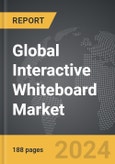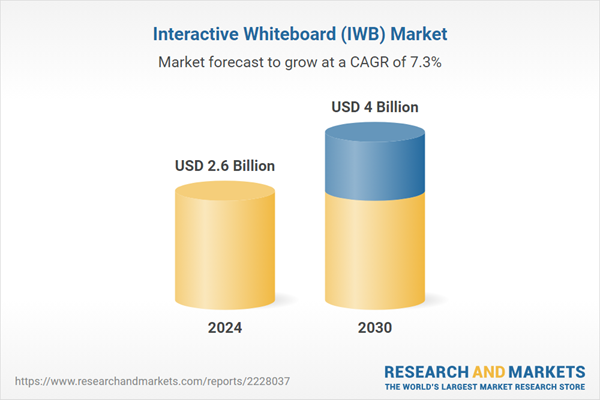The global market for Interactive Whiteboard (IWB) was valued at US$2.6 Billion in 2024 and is projected to reach US$4.0 Billion by 2030, growing at a CAGR of 7.3% from 2024 to 2030. This comprehensive report provides an in-depth analysis of market trends, drivers, and forecasts, helping you make informed business decisions. The report includes the most recent global tariff developments and how they impact the Interactive Whiteboard (IWB) market.
IWBs have become essential in several sectors, significantly impacting education and business practices. In educational settings, IWBs enrich classrooms by providing interactive experiences that engage students more effectively than traditional teaching methods. They support a variety of teaching activities, including group projects and interactive lessons that foster deeper learning and engagement in subjects like mathematics and language arts. For example, their use in group writing projects promotes thoughtful planning and collaboration, enhancing student writing skills, while in math classes, IWBs facilitate active problem-solving discussions. In corporate environments, IWBs enhance meetings and strategic planning sessions in boardrooms, and are invaluable in fields like engineering and coaching for communicating complex information clearly and engagingly. This adaptability makes IWBs particularly useful across different professional contexts and educational disciplines, proving their value in fostering comprehensive development and enhancing learning outcomes.
The growth and adoption of IWBs are driven by several key factors, including their ability to support collaborative learning and integrate with distance learning programs, which has become particularly important in the current educational landscape. The trend towards flipped classrooms, where students first engage with new content online, benefits from IWBs' capability to enrich in-class sessions through interactive and multimedia resources. Government initiatives promoting digital education tools and the growing use of IWBs in corporate settings for training and presentations reflect a wider acceptance and integration of this technology. Additionally, there is an increasing expectation for technology integration in educational and professional settings, prompting institutions to adopt sophisticated tools like IWBs. These factors, combined with technological advancements, are shaping a future where interactive whiteboards continue to enhance learning environments and business communication, making them indispensable tools in modern education and professional discourse.
Segments: Technology (Resistive Membrane, Electromagnetic Pen, Infrared, Capacitive, Other Technologies); Projection Technique (Front Projection, Rear Projection); End-Use (Education, Corporate, Commercial, Other End-Uses).
Geographic Regions/Countries: World; United States; Canada; Japan; China; Europe (France; Germany; Italy; United Kingdom; and Rest of Europe); Asia-Pacific; Rest of World.
The analysts continuously track trade developments worldwide, drawing insights from leading global economists and over 200 industry and policy institutions, including think tanks, trade organizations, and national economic advisory bodies. This intelligence is integrated into forecasting models to provide timely, data-driven analysis of emerging risks and opportunities.
Global Interactive Whiteboard (IWB) Market - Key Trends and Drivers Summarized
Interactive Whiteboards (IWBs), also known as smartboards, represent a significant advancement in presentation and collaboration technology, integrating the traditional functionality of whiteboards with sophisticated digital features. These tools have transformed educational and professional environments by facilitating dynamic interactions and making complex information more accessible and engaging. The evolution of IWB technology ensures their continued relevance, integrating a range of interactive features that enhance learning and collaboration. IWBs employ various technologies, including infrared touch, where users interact with the board using fingers or special pens, and resistive or capacitive touch systems that respond to pressure or touch respectively. Some models also utilize magnetic or ultrasonic pens for precise inputs. This versatility in design and function allows IWBs to cater to diverse interaction styles and settings, enhancing user experience with digital tools like virtual rulers, compasses, and protractors that support an array of media types and enrich presentations and educational content.IWBs have become essential in several sectors, significantly impacting education and business practices. In educational settings, IWBs enrich classrooms by providing interactive experiences that engage students more effectively than traditional teaching methods. They support a variety of teaching activities, including group projects and interactive lessons that foster deeper learning and engagement in subjects like mathematics and language arts. For example, their use in group writing projects promotes thoughtful planning and collaboration, enhancing student writing skills, while in math classes, IWBs facilitate active problem-solving discussions. In corporate environments, IWBs enhance meetings and strategic planning sessions in boardrooms, and are invaluable in fields like engineering and coaching for communicating complex information clearly and engagingly. This adaptability makes IWBs particularly useful across different professional contexts and educational disciplines, proving their value in fostering comprehensive development and enhancing learning outcomes.
The growth and adoption of IWBs are driven by several key factors, including their ability to support collaborative learning and integrate with distance learning programs, which has become particularly important in the current educational landscape. The trend towards flipped classrooms, where students first engage with new content online, benefits from IWBs' capability to enrich in-class sessions through interactive and multimedia resources. Government initiatives promoting digital education tools and the growing use of IWBs in corporate settings for training and presentations reflect a wider acceptance and integration of this technology. Additionally, there is an increasing expectation for technology integration in educational and professional settings, prompting institutions to adopt sophisticated tools like IWBs. These factors, combined with technological advancements, are shaping a future where interactive whiteboards continue to enhance learning environments and business communication, making them indispensable tools in modern education and professional discourse.
Report Scope
The report analyzes the Interactive Whiteboard (IWB) market, presented in terms of units. The analysis covers the key segments and geographic regions outlined below.Segments: Technology (Resistive Membrane, Electromagnetic Pen, Infrared, Capacitive, Other Technologies); Projection Technique (Front Projection, Rear Projection); End-Use (Education, Corporate, Commercial, Other End-Uses).
Geographic Regions/Countries: World; United States; Canada; Japan; China; Europe (France; Germany; Italy; United Kingdom; and Rest of Europe); Asia-Pacific; Rest of World.
Key Insights:
- Market Growth: Understand the significant growth trajectory of the Resistive Membrane segment, which is expected to reach US$1.4 Billion by 2030 with a CAGR of a 7.8%. The Electromagnetic Pen segment is also set to grow at 6.9% CAGR over the analysis period.
- Regional Analysis: Gain insights into the U.S. market, valued at $721.2 Million in 2024, and China, forecasted to grow at an impressive 6.9% CAGR to reach $618.5 Million by 2030. Discover growth trends in other key regions, including Japan, Canada, Germany, and the Asia-Pacific.
Why You Should Buy This Report:
- Detailed Market Analysis: Access a thorough analysis of the Global Interactive Whiteboard (IWB) Market, covering all major geographic regions and market segments.
- Competitive Insights: Get an overview of the competitive landscape, including the market presence of major players across different geographies.
- Future Trends and Drivers: Understand the key trends and drivers shaping the future of the Global Interactive Whiteboard (IWB) Market.
- Actionable Insights: Benefit from actionable insights that can help you identify new revenue opportunities and make strategic business decisions.
Key Questions Answered:
- How is the Global Interactive Whiteboard (IWB) Market expected to evolve by 2030?
- What are the main drivers and restraints affecting the market?
- Which market segments will grow the most over the forecast period?
- How will market shares for different regions and segments change by 2030?
- Who are the leading players in the market, and what are their prospects?
Report Features:
- Comprehensive Market Data: Independent analysis of annual sales and market forecasts in US$ Million from 2024 to 2030.
- In-Depth Regional Analysis: Detailed insights into key markets, including the U.S., China, Japan, Canada, Europe, Asia-Pacific, Latin America, Middle East, and Africa.
- Company Profiles: Coverage of players such as Boxlight, Cisco Systems, Inc., Foxconn Technology, Google Cloud Platform, Google, Inc. - Google Play and more.
- Complimentary Updates: Receive free report updates for one year to keep you informed of the latest market developments.
Some of the 53 companies featured in this Interactive Whiteboard (IWB) market report include:
- Boxlight
- Cisco Systems, Inc.
- Foxconn Technology
- Google Cloud Platform
- Google, Inc. - Google Play
- Hitachi Solutions Ltd.
- LG Display Co., Ltd.
- Luidia, Inc.
- Microsoft Corporation
- NEC Display Solutions Ltd.
- NetDragon Websoft, Inc.
- Panasonic Corporation
- QOMO HiteVision, LLC
- Returnstar Interactive Technology Group Co., Ltd.
- Ricoh Co., Ltd.
- Samsung Display Co., Ltd.
Tariff Impact Analysis: Key Insights for 2025
Global tariff negotiations across 180+ countries are reshaping supply chains, costs, and competitiveness. This report reflects the latest developments as of April 2025 and incorporates forward-looking insights into the market outlook.The analysts continuously track trade developments worldwide, drawing insights from leading global economists and over 200 industry and policy institutions, including think tanks, trade organizations, and national economic advisory bodies. This intelligence is integrated into forecasting models to provide timely, data-driven analysis of emerging risks and opportunities.
What’s Included in This Edition:
- Tariff-adjusted market forecasts by region and segment
- Analysis of cost and supply chain implications by sourcing and trade exposure
- Strategic insights into geographic shifts
Buyers receive a free July 2025 update with:
- Finalized tariff impacts and new trade agreement effects
- Updated projections reflecting global sourcing and cost shifts
- Expanded country-specific coverage across the industry
Table of Contents
I. METHODOLOGYII. EXECUTIVE SUMMARY2. FOCUS ON SELECT PLAYERSIII. MARKET ANALYSISCANADAITALYREST OF EUROPEREST OF WORLDIV. COMPETITION
1. MARKET OVERVIEW
3. MARKET TRENDS & DRIVERS
4. GLOBAL MARKET PERSPECTIVE
UNITED STATES
JAPAN
CHINA
EUROPE
FRANCE
GERMANY
UNITED KINGDOM
ASIA-PACIFIC
Companies Mentioned (Partial List)
A selection of companies mentioned in this report includes, but is not limited to:
- Boxlight
- Cisco Systems, Inc.
- Foxconn Technology
- Google Cloud Platform
- Google, Inc. - Google Play
- Hitachi Solutions Ltd.
- LG Display Co., Ltd.
- Luidia, Inc.
- Microsoft Corporation
- NEC Display Solutions Ltd.
- NetDragon Websoft, Inc.
- Panasonic Corporation
- QOMO HiteVision, LLC
- Returnstar Interactive Technology Group Co., Ltd.
- Ricoh Co., Ltd.
- Samsung Display Co., Ltd.
Table Information
| Report Attribute | Details |
|---|---|
| No. of Pages | 188 |
| Published | April 2025 |
| Forecast Period | 2024 - 2030 |
| Estimated Market Value ( USD | $ 2.6 Billion |
| Forecasted Market Value ( USD | $ 4 Billion |
| Compound Annual Growth Rate | 7.3% |
| Regions Covered | Global |









